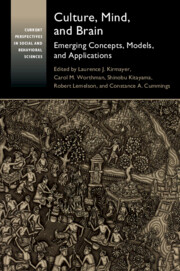Book contents
- Culture, Mind, and Brain
- Current Perspectives in Social and Behavioral Sciences
- Culture, Mind, and Brain
- Copyright page
- Dedication
- Epigraph
- Contents
- Figures
- Tables
- Contributors
- Preface
- Abbreviations
- 1 Introduction
- Part I Dynamics of Culture, Mind, and Brain
- Section 1 The Co-emergence of Culture, Mind, and Brain
- Section 2 The Situated Brain
- 5 Culture in Mind – An Enactivist Account
- 6 The Brain as a Cultural Artifact
- 7 Cultural Priming Effects and the Human Brain
- 8 Culture, Self, and Agency
- Section 3 How Social Coordination and Cooperation are Achieved
- Part II Applications
- Index
- References
7 - Cultural Priming Effects and the Human Brain
from Section 2 - The Situated Brain
Published online by Cambridge University Press: 18 September 2020
- Culture, Mind, and Brain
- Current Perspectives in Social and Behavioral Sciences
- Culture, Mind, and Brain
- Copyright page
- Dedication
- Epigraph
- Contents
- Figures
- Tables
- Contributors
- Preface
- Abbreviations
- 1 Introduction
- Part I Dynamics of Culture, Mind, and Brain
- Section 1 The Co-emergence of Culture, Mind, and Brain
- Section 2 The Situated Brain
- 5 Culture in Mind – An Enactivist Account
- 6 The Brain as a Cultural Artifact
- 7 Cultural Priming Effects and the Human Brain
- 8 Culture, Self, and Agency
- Section 3 How Social Coordination and Cooperation are Achieved
- Part II Applications
- Index
- References
Summary
Culture as shared values/beliefs and behavioral scripts not only influences human behavior and cognition but modulates the underlying brain activity as well. Cultural impacts on the human brain have been investigated by cultural neuroscience research that examines cultural group differences in brain activities involved in specific cognitive/affective processes. The findings, however, do not allow inference of causal relationships between specific cultural values/beliefs and brain activity. Cultural priming approach tests how brain activities underlying various cognitive/affective processes are modulated by recent exposure to specific cultural symbols or activation of specific cultural values/beliefs. Increasing evidence indicates that cultural priming leads to subsequent changes of brain activities in response to perception, attention, reward, self-reflection, etc. The findings suggest that culture provides a key frame in which the human brain develops and functions to mediate multiple cognitive and affective processes.
- Type
- Chapter
- Information
- Culture, Mind, and BrainEmerging Concepts, Models, and Applications, pp. 223 - 243Publisher: Cambridge University PressPrint publication year: 2020



